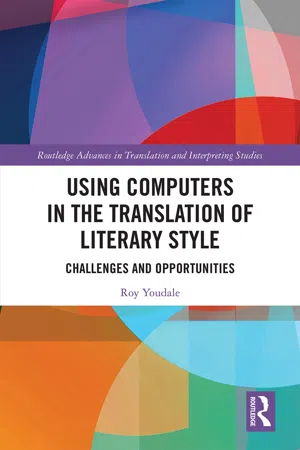
Using Computers in the Translation of Literary Style
Challenges and Opportunities
- 242 pages
- English
- ePUB (mobile friendly)
- Available on iOS & Android
About This Book
This volume argues for an innovative interdisciplinary approach to the analysis and translation of literary style, based on a mutually supportive combination of traditional close reading and 'distant' reading, involving corpus-linguistic analysis and text-visualisation. The book contextualizes this approach within the broader story of the development of computer-assisted translation -- including machine translation and the use of CAT tools -- and elucidates the ways in which the approach can lead to better informed translations than those based on close reading alone. This study represents the first systematic attempt to use corpus linguistics and text-visualisation in the process of translating individual literary texts, as opposed to comparing and analysing already published originals and their translations. Using the case study of his translation into English of Uruguayan author Mario Benedetti's 1965 novel Gracías por el Fuego, Youdale showcases how a close and distant reading approach (CDR) enhances the translator's ability to detect and measure a variety of stylistic features, ranging from sentence length and structure to lexical richness and repetition, both in the source text and in their own draft translation, thus assisting them with the task of revision. The book reflects on the benefits and limitations of a CDR approach, its scalability and broader applicability in translation studies and related disciplines, making this key reading for translators, postgraduate students and scholars in the fields of literary translation, corpus linguistics, corpus stylistics and narratology.
Frequently asked questions
1 Using Computers in Literary Translation
1.1 Computers and Translation: An Overview
The Development of Translation Technologies
every CAT system divides a text into “segments” (normally sentences, as defined by punctuation marks) and searches a bilingual memory for identical (exact match) or similar (fuzzy match) source and translation segments. Search and recognition of terminology in analogous bilingual glossaries are also standard. The corresponding search results are then offered to the human translator as prompts for adaptation and reuse.
- a predominantly web-based rather than hard drive-based working environment, involving translation teams rather than lone translators
- large online databases can now be accessed, such as TDA (TAUS Data Association)8 and the Google Translate Toolkit9
- term extraction tools can now bring language-specific knowledge to a CAT environment, which was previously like an empty shell waiting to be filled by TMs
- speech recognition text input is now being integrated into some CAT tools
- some sub-segmental matching from internal databases is now possible, as well as the use of predictive typing
- the convergence of MT with TM is growing, with advantages accruing from using a suggested MT version of a segment where there is ‘no match’ in the CAT tool or a fuzzy match below 70% similarity.10
The Impact of Translation Technologies on Translators: Some Key Issues
whereas much of the translator’s skillset and effort was previously invested in identifying possible solutions to translation problems (i.e., the generative side of the cognitive process), the vast majority of these skills and efforts are now invested in selecting between available solutions (i.e., the selective side of the cognitive processes).
I use translation memories when required to do so by clients, but find them of little benefit.Many of my (agency) clients would not work with me if I did not use a CAT tool, it is therefore an essential skill to learn.
Table of contents
- Cover
- Half Title
- Series Page
- Title Page
- Copyright Page
- Dedication Page
- Table of Contents
- List of Figures
- List of Tables
- Acknowledgements
- List of Abbreviations
- Introduction
- 1 Using Computers in Literary Translation
- 2 Analysing the Source Text: Structure and Style
- 3 CDR, Translation Theory and the Attempt to Create an ‘English Benedetti’
- 4 Applying the Methodology (Part 1): The Translation of Culture
- 5 Applying the Methodology (Part 2): The Translation of Punctuation
- 6 Applying the Methodology (Part 3): Comparing Source Text and Draft Translation
- 7 Applying the Methodology (Part 4): The Auto-analysis of Translator Style
- 8 Conclusions: Assessing the Potential of the Methodology
- Appendix A: Research Data
- Appendix B: Translations used for Chapter 7
- References
- Index